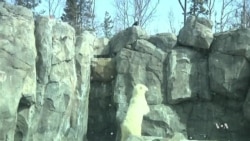For decades, humans and global climate change have been threatening the existence of polar bears. Scientists in Alaska are working hard to save as many of them as possible.
The zoo in Anchorage, Alaska, has been taking care of orphaned or abandoned polar bears since the 1970s.
Fifteen-year-old Ahpun was rescued as a cub by a hunter, who shot her mother after she attacked him.
Her mate Lyutyik was born in Russia's St. Petersburg Zoo. Scientists have paired them, hoping they would produce a cub and increase the population of the threatened species.
Patrick Lampi, Executive Director of the Alaska Zoo, says, “So, for years, we've been the holding facility, sometimes permanent, sometimes temporary, for orphaned cubs coming in, whether their parents were killed or they got separated in a storm.”
Lampi says the first three years cubs spend with their mothers are critical for survival. Orphaned cubs never have a chance to learn survival skills, so they can never go back into the wild.
U.S. Fish and Wildlife Service biologist, Susi Miller, says that the Alaska Zoo is their first stop.
“In the last five years especially, but actually for even longer now, 20 plus years, they've been helping us deal with orphaned cubs,” said Miller.
Out of approximately 20,000 polar bears worldwide, about 1,500 live on Alaska's northern coast, and an unknown number are found around the Bering and Chukchi Seas.
As warming temperatures diminish Arctic sea ice, the bears spend more time on land, where they are attracted to piles of whale and fish bones outside Alaskan native villages. Experts warn that increased encounters with humans, together with expanding tourism, may lead to more conflict and more cubs becoming orphans.
The Alaska Zoo is working to raise $8 million for a two-phase project, to expand the polar bear exhibit and build a Polar Bear Transition Centre, which will be able to accommodate more bears.
The zoo in Anchorage, Alaska, has been taking care of orphaned or abandoned polar bears since the 1970s.
Fifteen-year-old Ahpun was rescued as a cub by a hunter, who shot her mother after she attacked him.
Her mate Lyutyik was born in Russia's St. Petersburg Zoo. Scientists have paired them, hoping they would produce a cub and increase the population of the threatened species.
Patrick Lampi, Executive Director of the Alaska Zoo, says, “So, for years, we've been the holding facility, sometimes permanent, sometimes temporary, for orphaned cubs coming in, whether their parents were killed or they got separated in a storm.”
Lampi says the first three years cubs spend with their mothers are critical for survival. Orphaned cubs never have a chance to learn survival skills, so they can never go back into the wild.
U.S. Fish and Wildlife Service biologist, Susi Miller, says that the Alaska Zoo is their first stop.
“In the last five years especially, but actually for even longer now, 20 plus years, they've been helping us deal with orphaned cubs,” said Miller.
Out of approximately 20,000 polar bears worldwide, about 1,500 live on Alaska's northern coast, and an unknown number are found around the Bering and Chukchi Seas.
As warming temperatures diminish Arctic sea ice, the bears spend more time on land, where they are attracted to piles of whale and fish bones outside Alaskan native villages. Experts warn that increased encounters with humans, together with expanding tourism, may lead to more conflict and more cubs becoming orphans.
The Alaska Zoo is working to raise $8 million for a two-phase project, to expand the polar bear exhibit and build a Polar Bear Transition Centre, which will be able to accommodate more bears.






